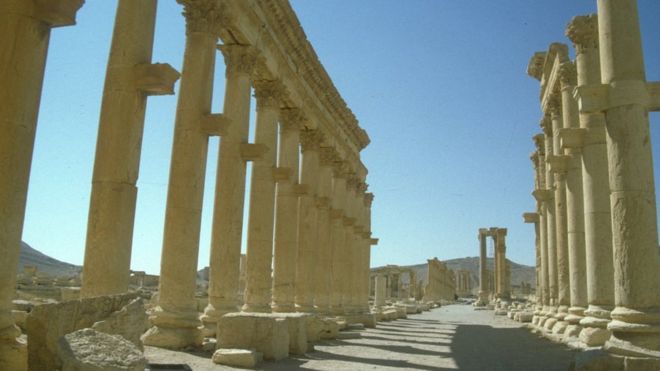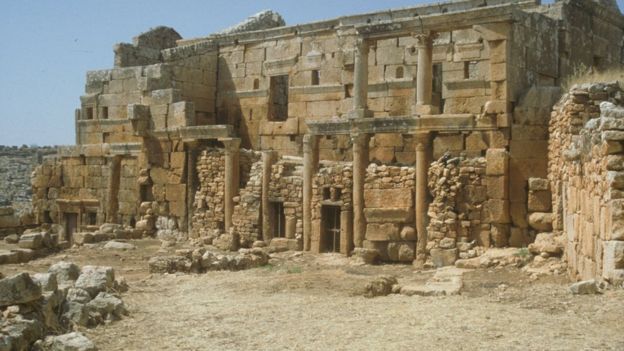DepthReading
Syria monuments damage 'akin to looting Welsh castles'
Palmyra has seen some of the worst damage to historical buildings inflicted in Syria
Destruction of Syria's historical monuments is akin to Wales' castles and Stonehenge being "looted and obliterated", an archaeologist has said.
Swansea University's Dr Nigel Pollard heads a team digitising pre-war images of the ancient world treasures.
The Syrian civil war has seen precious sites damaged.
Dr Pollard said people come first but Syria's heritage also needs protection.
"Imagine Wales' castles, Stonehenge and Hadrian's Wall being looted and seriously damaged. What's happening in Syria is comparable," he said.
The nation has historically been a melting pot of cultures, including Greeks, Persians, Romans, Christians, Muslims and Jews.
Dr Pollard, who worked in Syria before the conflict began in 2011, believes safeguarding the country's monuments and artefacts is important in creating a lasting and prosperous peace.
"Obviously the human tragedy of the Syrian civil war is the greatest priority, but it isn't a choice between people and monuments - cultural heritage is important in shaping and reflecting people's identity, and often economically important too," he said.
"It can play a crucial role in reconstructing communities after a conflict."
According to Dr Pollard, the destruction falls into three categories.
"Early in the war, from 2011-2015, much of the devastation came in the form of looting of unprotected sites and 'collateral damage' in combat," he said.
"For example, in the Roman city of Apamea in Hama province, damage was caused by government forces shelling the rebels.
"Whilst no care was taken to protect the city, its destruction wasn't the main aim, and in these places some restoration work may eventually be possible. Similar severe damage has been inflicted on historic sites in recent fighting in Aleppo.
"But in the case of Palmyra, ISIS (the so-called Islamic State) have systematically set about destroying some of the key monuments, and little is left apart from rubble, so meaningful restoration will be impossible."
'More can be done'
But, while no physical protection can be afforded until the fighting has stopped, Dr Pollard is working on ways in which the sites could be partially saved from afar.
He is a member of the UK National Committee of the Blue Shield organisation - often described as the cultural version of the Red Cross - which co-ordinates international work in this area.
He said: "Whilst there are some things which can be achieved through diplomacy - the Syrian regime and some of the rebels are finally starting to realise how vital the monuments will be to the post-war economy whoever wins out - mostly we have to look at what we can do here and now."
Dr Nigel Pollard says monuments like this tomb at al-Bara (right) must be protected
For example, more can be done to stem the trade in looted antiquities by supporting the training and resourcing of officials in neighbouring countries, such as Turkey and Lebanon, to clamp down on smuggling, Dr Pollard said.
"There is also much we can do to better co-ordinate preservation work being carried out by disparate organisations," he added.
Dr Pollard believes the UK government deserves credit for leading international opinion.
It has already established a fund to support some projects and its Cultural Protection Bill - to safeguard items and sites threatened by conflict - has passed its second reading in the Commons and could become law early in 2017.
This farm facade with a portico is at Sergilla - one of northern Syria's "Dead Cities"
Meanwhile, UK armed forces are setting up a new "Monuments Men" unit of specialists in cultural property protection.
However, Dr Pollard doubts whether many of Syria's ancient wonders can be saved, nor whether they ought to be.
"In places such as Palmyra, which have been razed to the ground, all you'd achieve by attempting to rebuild would be to create some sort of Roman theme park," he said.
"Sadly, given what has already happened, I think we will have to accept that this war is part of the wider history of the sites, preserve whatever is left, and use the artefacts we can gather in order to tell their story for future generations."
Category: English
DepthReading
Key words:



